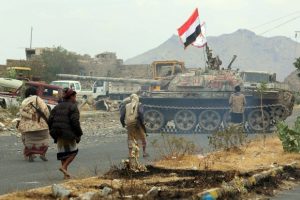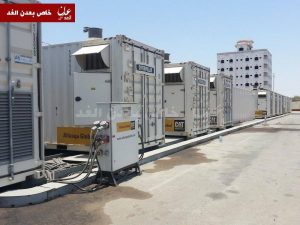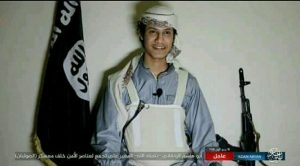The military situation has changed very little in the course of the past months in Yemen, but armed disputes have become less frequent with the exception of some unyielding front lines. The Saudi air forces, however, continued attacking the country from North Yemen to South Taiz with cluster bombs and other weapons, but with less frequency, while alQaida has become most active, defending their retreat areas in alBeidha, Schabwa and Abyan against the Houthi/Saleh-troops und and struggling for survival with the Hizam-Brigades in the South.
Peace negotiations are chanceless at the time being with a view to the prerequisites and conditions of the “International Community” (consisting of the US, the UK, the KSA und the VAE), and keep being postponed. Never the less, the course for the post war alignment is being set in the different parts of the country, showing a drifting apart of the latter. The changes are most obvious in bigger towns where the new peacekeeping powers endeavour to get consolidated.
Aden
18 months after the end of war activities the infrastructure has become almost fully operational again in Aden, although power cuts are daily fare. The modern diesel generators supplied by the Emirates have to be switched off temporarily because of a lack of fuel. Waste disposal and the sewage system have improved too. The ever and again announced reopening of the airport has taken effect to a limited extent only: a newly established private “Queen Bilqis Airline” is to connect Aden and Mukalla-Ryan with international destinations. The flamboyant announcement of a reinstallation of the port has become a very slow process indeed. Aden University has been active with the exception of three months in the spring of 2015 but has been subjected to new legal prerequisites and curricula as well as requirements for mainstream studies and appointments. The courts, the security organs and the public administration still do not function.
Image: The new diesel generators supplied by the Emirates are temporarily out of order because of a lack of fuel
Abdrubbah Mansur Hadi has been residing at the presidential palace Maschiq in Aden-Tawahi since the end of November but for security reasons is going out only sporadically, some time ago for a one-week visit to Mukalla. Critics are worried Hadi might be selling off Yemeni resources and interests in order to finance his regime.
At the end of December – in the wake of the transfer of the central bank from Sana´a to Aden – the military personnel received their pay for the first time after three months which somehow calmed the situation. According to Hadi Aden was to become a model city as the “provisional capital“, a so far pitifully unsuccessful attempt, above all because of the unstable and insecure situation. The car bomb attacks Daash employs for advertising and recruiting, periodically kill and wound above all masses of young recruits. At times up to 18 armed groups and militia have been acting, bringing about an escalation of the chaos and bewilderment of the population. Various militia carry out checks at every 100 metres, demarcating ”their“ territories in arms.
Image: Daash tries to recruit by means of this photo of a young suicide bomber (with an explosive belt) who killed 40 soldiers and injured 50 in Aden on 19/12/ 2016
Numerous Adanis have demonstrated against the shortcomings, burnt tires in the streets and erected blockades to protest against the lack of fuel, the power cut offs, the lack of public services and the insecure situation. This has given new impetus to the Secessionists.
Hadi is now trying to obtain supremacy over the militia or eliminate it. The most important representatives are the so-called “Hizam-Brigades” (security belt brigades), associations in the Southern provinces established and financed by the Emirates (possibly also by the KSA and Qatar). The so far approx.15.000 security forces of “Hizam” have been recruited in South Yemen and trained by Emirati officers above all in combatting terror in four provinces, and are said to be selectively launched against alQaida and Daash, which in turn has made them become a target of the two terror organizations. AlQaida is progressing at the expense of Daash, possibly because it succeeds in mobilising resistance against the „occupation forces“ and engages in mortal fights against military opponents, political leaders and the cleric. The Hizam high commands, on the other hand, allegedly consist of fundamentalist Salafists. The Hizam have not endeared themselves so far to the Adani population because of acting in a harshly molesting style, and have so far not been following Hadi´s command, but have been financed by the occupation forces direct and are therefore heteronomous. They threaten the population and have their own prisons. The tensions between Hadi and Hizam associations point towards tensions between Hadi and the Emirates, who apparently support him only since they need a legal entity for legally binding involvements in the South.
Marib
The governor of the central province of Marib with important oil and gas deposits is Sultan alArada, who is a follower of Hadi´s and has been cooperating with the Saudi occupation forces. The majority of the tribes, representing the mightiest social power in Marib, is assumed to support the Salafist alArada. Marib was the first stronghold of the Saudi ground invasion in May 2015. At the very beginning suffering from a heavy setback by a rocket attack, Saudi troops no longer take part in battles on the ground
since then. Although foreign militia are present in Marib and also in the Southern provinces, primarily from the Emirates, Saudi Arabia and the USA but entrench themselves for security reasons in barracks and army camps. Battles have been going on for a year without any major displacements of the frontlines only in the mountainous Western part of the province at the border to the vicinity of Sana´a, above all in the former Sabaean metropolis of Sirwah and in Nehm. The provincial capital Marib has become a tribally coined small town with approx. 30.000 inhabitants, but appears to be earmarked for an important future in line with the steadily rising construction activities observed. New houses keep being erected. The building owners are mostly new arrivals from the areas occupied by the Houthis, and increasingly represent proponents of the Islah-Party, adherents of the Salafists, the Muslim brothers, tribal sheikhs and North Yemenis from Hadi´s circles, but also proponents of Moutamar who broke away from Saleh´s Moutamar, followed Hadi into exile and have chosen Marib as their new location. They come from Amran, Sana´a, Dhamar und other towns in the North, currently ruled by the Houthis and Moutamar. These internally displaced persons, many of whom have been temporarily outside the country, obviously no longer expect a possible return to Sana´a or other towns on the North in a foreseeable future. No longer considering a return possible even in the longer term and expecting Marib to become the capital of the the Saba region they hope that the federal structure as concluded in the National Dialogue conference in 2013/14 will come true so that Marib will be the capital of the region with the provinces of Marib, alJawf and alBeidha. Property prices are already soaring in Marib.
Taiz
Some observers compare the situation in Taiz with that in Aleppo. Ferocious battles have been going on since the beginning of the war at the end of March 2015. The situation might well be attributed to an irony of fate that the most liberal, richest and freest city in Yemen should have become the scene of fierce and partly also sectarian battles. The core of Taiz is supported by a resistance movement endeavouring to hold the city, situated in a hollow, by all means, in particular artillery, under the command of Hamud alMikhlafi. The resistance in the city of Taiz, now characterized by Salafists, does certainly not represent the basic ideology of the majority of the population who only desires peace. The Houthi and Saleh associations lay siege to the city from the mountains around with heavy weaponry. After 20 months of war parts of the city are as destroyed as Aleppo. Moreover, airplanes of the Saudi coalition often drop bombs over the city and the vicinity. Both war parties, in particular the beleaguerers, have committed human rights violations. Many of the more than half a million inhabitants have deserted the embattled eastern parts of the city. The circumvallation around the city has caused a severe shortage of supplies of food and medicines. Merchandise is smuggled into the city on donkey paths and cost a fortune.

Yemeni fighters loyal to Yemen’s exiled President Abedrabbo Mansour Hadi, drive a tank during clashes with Shiite Huthi rebels in the country’s third-city of Taez on December 19, 2016. / AFP PHOTO / Ahmad AL-BASHA
Members of the “Volkswiderstand“ Salafistic Militia, disliked by most of the population, in extensively destroyed Taiz
“Shooting and looting” is the tactic of the militia in “liberated” Taiz, where hate between fundamentalist Sunnis and Zeidis keeps dangerously growing because of the armed escalation and the misery of the population. Deserted houses are immediately plundered by Salafistic militia, inhabitants abducted and missing for weeks. Complaints also refer to militia opening house doors by shooting upon having occupied a street and ransacking the house. No area, no town in Yemen – with the exception of Saada – has been as brutally stricken as Taiz. Especially the middle classes suffer most in this war: houses are destroyed and plundered, many schools are closed, public servants have not been paid their salaries for months, many are out of work and have to spend their savings or sell property to survive. Refrigerators, TV sets, washing machines and furniture of all kind are offered on the market in Taiz at half their value. Many people feel terrorized by both sides of the front. A worn out Taizi complains:
“I cannot trust either the Houthis nor the resistance to control my city as both of them do not care about the civilians”. Plundering is also experienced in the areas occupied by the Houthis around Taiz.
However, the situation in zones controlled by the Houthis is essentially more favourable since the police, schools, hospitals and courts function as compared to the areas occupied by the militia. Sometimes also alQaida-warriors have joined the “muqawama schabia” (people´s resistance) in fighting the Houthi occupation, but this is said to be no longer the case. Never the less, it is a fact that the militia rather destroy what order had remained and spread anarchy, thus creating an ideal climate for the terror organizations.

